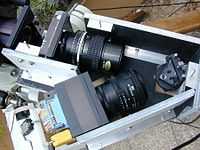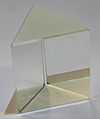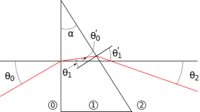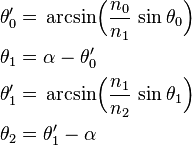Spectrographs

This problem set is designed for astronomy to help the student, teacher, and researcher understand the inner workings of a spectrograph.
Evaluation
|
Spectrography


 ,
,  , and
, and  , and primed angles
, and primed angles  indicate the ray angles after refraction. Credit: NathanHagen.
indicate the ray angles after refraction. Credit: NathanHagen.Def. a "machine for recording spectra, producing spectrograms"[1] is called a spectrograph.
Def. a "visual representation of the spectrum of a celestial body's radiation"[2] is called a spectrogram.
A "prism is a transparent optical element with flat, polished surfaces that refract light [over a range of wavelengths]. At least two of the flat surfaces must have an angle [α] between them. The exact angles between the surfaces depend on the application. The traditional geometrical shape is that of a triangular prism with a triangular base and rectangular sides, and in colloquial use "prism" usually refers to this type."[3]
"Ray angle deviation and dispersion through a prism can be determined by tracing a sample ray through the element and using Snell's law at each interface. For the prism shown at right, the indicated angles are given by"[3]
 .
.
"For a prism in air  . Defining
. Defining  , the deviation angle
, the deviation angle  is given by"[3]
is given by"[3]
"If the angle of incidence  and prism apex angle
and prism apex angle  are both small,
are both small,  and
and  if the angles are expressed in radians. This allows the nonlinear equation in the deviation angle
if the angles are expressed in radians. This allows the nonlinear equation in the deviation angle  to be approximated by"[3]
to be approximated by"[3]
"The deviation angle depends on wavelength through n, so for a thin prism the deviation angle varies with wavelength according to"[3]
![\delta (\lambda) \approx [ n (\lambda) - 1 ] \alpha](../I/m/0cef05c95b70546fb71d5d60c4e1cc3f.png) .
.
Problem 1
The image at the top of this resource appears to have a deviation angle of 45°. The detector may be about 4 cm from the prism. Using a refractive index n = 1.732 and a representative wavelength for the optical colors calculate the width of each wavelength channel and the total detector width to capture the incoming photons. Use an apex angle of 35°.
Problem 2
Let the deviation angle be 30°, the detector distance be half a meter with the same refractive index and apex angle of 37.5°.
For the optical colors calculate the width of each wavelength channel and the total detector width to capture the incoming photons.
Problem 3
Using the configuration of Problem 2 and assuming a prism for X-rays and gamma rays existed, calculate the width of each wavelength channel, for five representative wavelengths of each, and the total detector width to capture the incoming photons.
Problem 4
Using the configuration of Problem 1 and representative wavelengths for each of the infrared bands described in infrared astronomy, calculate the width of each wavelength channel and the total detector width to capture the incoming photons.
Problem 5
Using each configuration of the problems above and representative wavelengths for submillimeter, microwave, and radio waves, calculate the width of each wavelength channel and the total detector width to capture the incoming photons.
Research
Hypothesis:
- Amateur astronomers may be able to build or buy a spectrograph.
Control groups

The findings demonstrate a statistically systematic change from the status quo or the control group.
“In the design of experiments, treatments [or special properties or characteristics] are applied to [or observed in] experimental units in the treatment group(s).[4] In comparative experiments, members of the complementary group, the control group, receive either no treatment or a standard treatment.[5]"[6]
Proof of concept
Def. a “short and/or incomplete realization of a certain method or idea to demonstrate its feasibility"[7] is called a proof of concept.
Def. evidence that demonstrates that a concept is possible is called proof of concept.
The proof-of-concept structure consists of
- background,
- procedures,
- findings, and
- interpretation.[8]
Proof of technology
"[T]he objective of a proof of technology is to determine the solution to some technical problem, such as how two systems might be integrated or that a certain throughput can be achieved with a given configuration."[9]
Def.
- "[a]n original object or form which is a basis for other objects, forms, or for its models and generalizations",[10]
- "[a]n early sample or model built to test a concept or process",[10] or
- "[a]n instance of a category or a concept that combines its most representative attributes"[10] is called a prototype.
Def. "[t]o test something using the conditions that it was designed to operate under, especially out in the real world instead of in a laboratory or workshop"[11] is called "field-test", or a field test.
A "proof-of-technology prototype ... typically implements one critical scenario to exercise or stress the highest-priority requirements."[12]
"[A] proof-of-technology test demonstrates the system can be used"[13].
"The strongest proof of technology performance is based on consistency among multiple lines of evidence, all pointing to similar levels of risk reduction."[14]
See also
References
- ↑ "spectrograph, In: Wiktionary". San Francisco, California: Wikimedia Foundation, Inc. October 8, 2013. Retrieved 2014-03-24.
- ↑ "spectrogram, In: Wiktionary". San Francisco, California: Wikimedia Foundation, Inc. June 19, 2013. Retrieved 2014-03-24.
- 1 2 3 4 5 "Prism, In: Wikipedia". San Francisco, California: Wikimedia Foundation, Inc. March 21, 2014. Retrieved 2014-03-25.
- ↑ Klaus Hinkelmann, Oscar Kempthorne (2008). Design and Analysis of Experiments, Volume I: Introduction to Experimental Design (2nd ed.). Wiley. ISBN 978-0-471-72756-9. http://books.google.com/?id=T3wWj2kVYZgC&printsec=frontcover.
- ↑ R. A. Bailey (2008). Design of comparative experiments. Cambridge University Press. ISBN 978-0-521-68357-9. http://www.cambridge.org/uk/catalogue/catalogue.asp?isbn=9780521683579.
- ↑ "Treatment and control groups, In: Wikipedia". San Francisco, California: Wikimedia Foundation, Inc. May 18, 2012. Retrieved 2012-05-31.
- ↑ "proof of concept, In: Wiktionary". San Francisco, California: Wikimedia Foundation, Inc. November 10, 2012. Retrieved 2013-01-13.
- ↑ Ginger Lehrman and Ian B Hogue, Sarah Palmer, Cheryl Jennings, Celsa A Spina, Ann Wiegand, Alan L Landay, Robert W Coombs, Douglas D Richman, John W Mellors, John M Coffin, Ronald J Bosch, David M Margolis (August 13, 2005). "Depletion of latent HIV-1 infection in vivo: a proof-of-concept study". Lancet 366 (9485): 549-55. doi:10.1016/S0140-6736(05)67098-5. http://www.ncbi.nlm.nih.gov/pmc/articles/PMC1894952/. Retrieved 2012-05-09.
- ↑ "Proof of concept, In: Wikipedia". San Francisco, California: Wikimedia Foundation, Inc. December 27, 2012. Retrieved 2013-01-13.
- 1 2 3 "prototype, In: Wiktionary". San Francisco, California: Wikimedia Foundation, Inc. December 8, 2013. Retrieved 2014-01-03.
- ↑ "field-test, In: Wiktionary". San Francisco, California: Wikimedia Foundation, Inc. August 5, 2012. Retrieved 2013-01-13.
- ↑ A. Liu; I. Gorton (March/April 2003). "Accelerating COTS middleware acquisition: the i-Mate process". Software, IEEE 20 (2): 72-9. doi:10.1109/MS.2003.1184171. http://cin.ufpe.br/~redis/intranet/bibliography/middleware/liu-cots03.pdf. Retrieved 2012-02-15.
- ↑ Rhea Wessel (January 25, 2008). "Cargo-Tracking System Combines RFID, Sensors, GSM and Satellite". RFID Journal: 1-2. http://www.rfidjournal.com/article/pdf/3870/1/1/rfidjournal-article3870.PDF. Retrieved 2012-02-15.
- ↑ P. Suresh, C. Rao, M.D. Annable and J.W. Jawitz (August 2000). E. Timothy Oppelt. ed. [http://www.afcee.af.mil/shared/media/document/AFD-071003-081.pdf#page=108 In Situ Flushing for Enhanced NAPL Site Remediation: Metrics for Performance Assessment, In: Abiotic In Situ Technologies for Groundwater Remediation Conference]. Cincinnati, Ohio: U.S. Environmental Protection Agency. pp. 105. http://www.afcee.af.mil/shared/media/document/AFD-071003-081.pdf#page=108. Retrieved 2012-02-15.
External links
- African Journals Online
- Bing Advanced search
- Google Books
- Google scholar Advanced Scholar Search
- International Astronomical Union
- JSTOR
- Lycos search
- NASA/IPAC Extragalactic Database - NED
- NASA's National Space Science Data Center
- Office of Scientific & Technical Information
- Questia - The Online Library of Books and Journals
- SAGE journals online
- The SAO/NASA Astrophysics Data System
- Scirus for scientific information only advanced search
- SDSS Quick Look tool: SkyServer
- SIMBAD Astronomical Database
- SIMBAD Web interface, Harvard alternate
- Spacecraft Query at NASA.
- SpringerLink
- Taylor & Francis Online
- Universal coordinate converter
- Yahoo Advanced Web Search
| ||||||||||||||||||||||||||||||||
| ||||||||||||||||||||||||||||||||||||||||||||
| |||||||||||||||||||||||||||||
| |||||||||||||||||||||||||||||||||||
| |||||||||||||||||||||||||||||||||||||||||
![]() This is a research project at http://en.wikiversity.org
This is a research project at http://en.wikiversity.org
| |
Development status: this resource is experimental in nature. |
| |
Educational level: this is a research resource. |
| |
Subject classification: this is an astronomy resource. |
| |
Subject classification: this is an astrophysics resource. |
| |
Subject classification: this is a materials science resource. |
![\delta = \theta_0 + \theta_2 = \theta_0 + \text{arcsin} \Big( n \, \sin \Big[\alpha - \text{arcsin} \Big( \frac{1}{n} \, \sin \theta_0 \Big) \Big] \Big) - \alpha](../I/m/3a19e99dba2aa6ee746e45dd366d5b46.png)
![\delta \approx \theta_0 - \alpha + \Big( n \, \Big[ \Big(\alpha - \frac{1}{n} \, \theta_0 \Big) \Big] \Big) = \theta_0 - \alpha + n \alpha - \theta_0 = (n - 1) \alpha \ .](../I/m/4886624a681f94039fb54a24a3fac5aa.png)